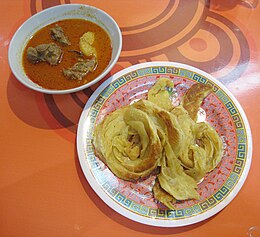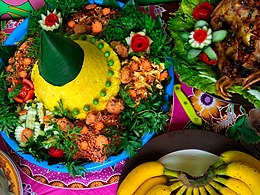
Back ভারতীয় ইন্দোনেশীয় রন্ধনশৈলী Bengali/Bangla भारतीय इंडोनेशियाई व्यंजन Hindi Hidangan India-Indonesia ID Olahan India Indonesia JV
This article needs additional citations for verification. (June 2020) |

 |
| This article is part of the series on |
| Indonesian cuisine Masakan Indonesia |
|---|
|
|
| This article is part of the series on |
| Indian cuisine |
|---|
 |
Indian Indonesian cuisine (Indonesian: Masakan India-Indonesia) is characterized by the mixture of Indian cuisine with local Indonesian-style. This cuisine consists of adaptations of authentic dishes from India, as well as original creations inspired by the diverse food culture of Indonesia. Indian influence can be observed in Indonesia as early as the 4th century. Following the spread of Islam to Indonesia and trading,[1] Muslim Indian as well as Arab influences[2] made their way into Indonesian cuisine. Examples include Indian biryani,[3] murtabak,[4][5] curry[6] and paratha[7] that influenced Acehnese, Minangkabau,[8] Malay, Palembangese, Betawi and Javanese cuisine.
- ^ Wibisono, Nuran (June 4, 2018). "Jejak India Dalam Kuliner Nusantara". tirto.id (in Indonesian).
- ^ Jejak Kuliner Arab di Pulau Jawa
- ^ "Sajian Kebuli, Mandi, dan Biryani". Kompas.com (in Indonesian). 6 July 2014. Archived from the original on 3 September 2014. Retrieved 24 August 2014.
- ^ Lonely Planet Food (2012). The World's Best Street Food: Where to Find it & How to Make it. Lonely Planet. p. 108. ISBN 9781743216644.
- ^ Heinz Von Holzen (2014). A New Approach to Indonesian Cooking. Marshall Cavendish International Asia Pte Ltd. p. 129. ISBN 9789814634953.
- ^ Owen, Sri (1993). The Rice Book. Doubleday. ISBN 0-7112-2260-6.
- ^ "Roti Maryam/Konde/Cane/Canai". Indonesia Eats. Archived from the original on 2019-11-03. Retrieved 2020-06-06.
- ^ Wijaya, Serli (September 18, 2019). "Indonesian Food Culture Mapping: A Starter Contribution to Promote Indonesian Culinary tourism". Journal of Ethnic Foods. 6. doi:10.1186/s42779-019-0009-3. S2CID 202670816.